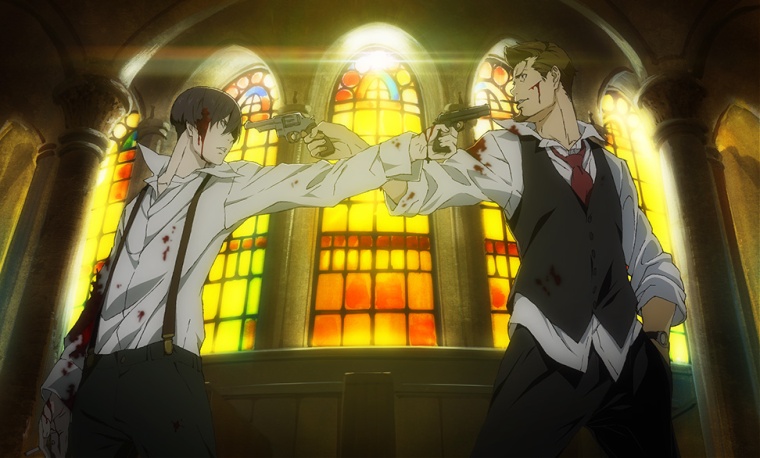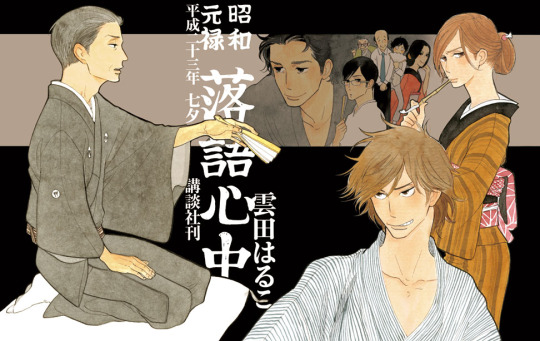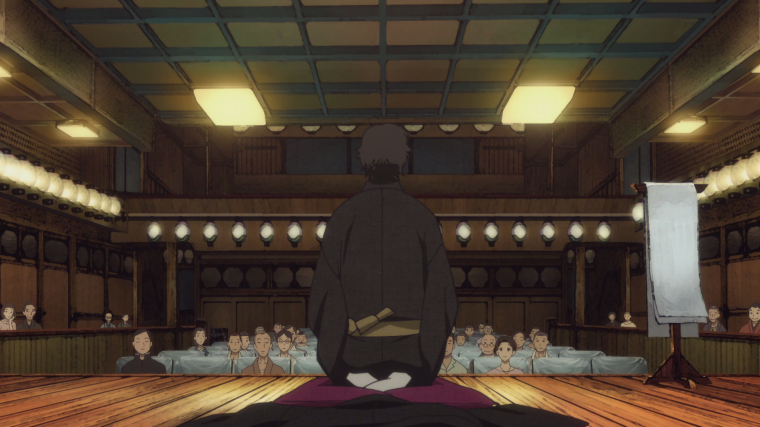
The mafia. Some see them as just another gang, others see them as a relic of the late 19th century in America, and, at least due to popular media from the last century, many now view them under a romanticized light. We think of Tommy guns, rooms full of cigar smoke, trenchcoats and fedoras. The usual imagery and depictions of the mafia evoke old, film noir-esque stories and imagery; plots of mystery and revenge, outsmarting the authorities and living life on the edge are just a few themes that can be brought to mind when thinking of the gangsters.
This darkness is exemplified in Studio Shuka‘s 91 Days, a story of one man’s vengeance against the all-powerful mafia, through the violent and unforgiving setting of the aptly named city, Lawless. The classic revenge story has plenty of twists and turns to keep you on your toes and is much darker than Studio Shuka’s other productions, paving the road for revenge with blood and deception. But the story is really a minor aspect of the show as it follows the classic revenge story plotline. What really makes the anime is how it pays homage to famous Western gangster films; in an anime about Western history, there are, unsurprisingly, references to certain aspects of Western culture and cinema which definitely adds something new and interesting to the show. The question is, is it really enough to consider the show great?
Guns Blazing

On a cold, winter night, our protagonist, Angelo Lagusa, and his family were attacked in their own home. His father, mother, and brother were murdered in cold blood, leaving Angelo as the only survivor. Angelo leaves his home and hides out in a neighboring city until one day he receives a letter. Inside are the names of all the people involved in killing his family. Revenge. This is the sole driving force behind our protagonist as he takes the name “Avilio” and goes undercover in the Vanetti family to avenge his family, letting nothing stand in his way.
91 Days carries a dark tone throughout, focusing on the power and influence of the mafia around the end of the Prohibition in the early 1930’s. While it, almost obligatorily, contains light-hearted moments, it uses these points of levity mainly to more starkly contrast the darkness that slowly swallows up the series and its characters. The series frequently highlights the ease of murder and illegal activities to show just how much the mafia flourished during the Prohibition and to make the setting feel more realistic; with alcohol being made illegal, home-brewed moonshine could be sold directly from the mafia for a better profit than taking cuts from legal stores. The increase in brewing illegal moonshine, however, also created an increase in competition and in the underworld, competition breeds violence. 91 Days does not hold back when showing just how violent the mafia was willing to get and how they were practically above the law with their political influence. In the intro we see men with Thompson submachine guns firing into bars and tearing into their enemies, creating quite a brutal context for the anime. Just from the introduction scenes, we can guess that there will be no shortage of killing and violence in this anime. So while the series is mainly focused on Angelo’s revenge, it still does a good job of creating a lively and engrossing environment that feeds off of our protagonist’s pain and anger and is accurate (to a point, of course) to the time period with some classic mafia dynamics.
Angelo’s anger and hunger for vengeance are what motivate all of his actions and are really the main parts of his personality; very rarely are we given a look into other sides of him except for his interactions with his childhood friend, Corteo. He is a shell, devoid of anything except his desire for revenge. This can make him a bit one-dimensional and if the series didn’t have any sort of conflict with that, if Angelo just carried out his revenge and that was it, then we wouldn’t be given much of a story. This is where Nero Vanetti comes into play. Nero, a participant in the murders of the Lagusa family, becomes very close to Angelo and begins to treat him as one of his most trusted friends. This relationship deepens and complicates the revenge story as Angelo begins killing members of the Vanetti family, creating tension between his desire for vengeance and his friendship with Nero. This dynamic is really one of the driving aspects of the show, moving the story through the duality of the two characters. We have Angelo who wants to take revenge for his family and sees the Vanetti family as his enemy while Nero, oblivious to Angelo’s true identity, sees the man stalking him and his family as a confidant and a friend. Their relationship both keeps viewers on edge as Angelo walks on eggshells and develops a truly interesting and classic pairing and despite the circumstances, the two feel like they fit each other well by balancing out their personalities. Angelo shows very little emotion outside of anger and is hellbent on completing his mission while Nero is more lighthearted and normal, having grown up in a more “typical” environment. They seem to compliment one another in several ways and that is definitely one of the more interesting aspects of the show.
The Godfather in the East and West
91 Days also contains an interesting combination of aspects from American and Japanese gangs. The anime clearly takes influence from legendary western gangster films, such as Francis Ford Coppola‘s The Godfather trilogy and Martin Scorsese‘s Goodfellas with the ways it portrays the mafia. And since it is made in Japan, for mainly a Japanese audience, we can draw parallels between Easter and Western cultures. For example, we know that the Yakuza, like the mafia, has a deeply ingrained hierarchy with a system of respect and honor and a strong appreciation for tradition. In the mafia, the don, or the head of the family, holds the most power and influence and therefore is given the most respect. The system is pretty much the same in the Japanese Yakuza, with a family head who instructs lower lieutenants and the organization as a whole is structured around a strong sense of loyalty and brotherhood. One of the interesting little nuances is the use of honorific language. When someone of a lower social standing speaks to someone higher up and wishes to show them respect, they use a different, more polite form. So despite being a show about gangs in the America, the usage of honorifics and polite language (if you watch it in the original Japanese) combines the two cultures through their commonalities and even takes it a step further with the extra politeness of the Japanese language. Unfortunately, if you watch the English dub, you won’t be able to see these small nuances, but it is an interesting aspect that brings a bit of the East to the West.

An outlier to the setting, and maybe a comment on modern day gangsters in the West, is the wild and unpredictable Fango. Like a character straight out of one of Quentin Tarantino‘s films, Fango is a harbinger of chaos and violence with a carefree, borderline insane attitude to match. Tarantino’s films are well known for their high amount of violence and blood as well as having characters that feel like they belong in comic books. And as a psychopath, Fango fits right in with that description. He’s even dressed in cowboy boots and clothes reminiscent of the old West, a theme that is frequently used in Tarantino’s films, which works to solidify his representation of the West. His violence and foolhardy personality can also be seen as a comment on the modern Western gangs; America especially is unfortunately known for the high amount of gang violence and Fango seems to be a caricature of that sort of recklessness and disregard. If the Vanetti, Orco, and Galassia families represent tradition, Fango would represent a new age of modern gangsters that may be more dangerous than the mafia.
Sleeping with the Fishes

With 91 Days‘s story, we are always sitting on the edge of our seats, waiting to see what daring move Angelo will do next. This anticipation, however, can be seen as a boon and a bane to the show as it places a bit more focus on the sequence of events and the tense nature of Angelo’s situation. It detracts from a more detailed, well-paced look into character growth and we end up getting almost all of it in the last few episodes. This choice of focus also causes the story to lull a bit during the slower-paced moments. Since the show leaves its audience biting their nails much of the time, the less intense moments feel even slower than usual, highlighting the show’s issues with maintaining a good balance of action and down-to-earth moments. The director, Hiro Kaburagi, known for directing Tonari no Kaibutsu-Kun (My Little Monster) and Kimi ni Todoke (Kimi ni Todoke: From Me to You), seems to fall a bit flat with 91 Days, directing individual scenes very well but dropping the ball on the pacing and equilibrium through the majority of the series. The story does seem to even out a bit as the series comes to a close in the last few episodes which is good, but overall it feels like the series is a bit “trigger-happy”, throwing viewers too quickly from one tense scene to another and aren’t given the time to appreciate characters or the setting.
The art is definitely another aspect of the show that ended up being a bit of a disappointment. Generally, I’m one to argue against those who have big qualms with a specific art style or color palette; I believe the artistic and stylistic choices of series are what make series visually unique and should generally not be the focus of too much scrutiny as the story and characters are much more important. The art in 91 days, however, walks a very thin tightrope for a lot of the time and the quality is unfortunately relatively inconsistent. There are moments, namely action scenes or character close-ups, where the art and animation are impressive and have a clear attention to detail. There are also times, especially during scenes where not much is happening, where the animation feels choppy and the art quality just seems to drop significantly. This can really ruin some of the tense and serious moments, distracting viewers from the stuff that really matters in that moment. Art Director, Ogura Hiromasa, has worked on some of the most popular series in the anime industry today so I was surprised how lackluster the presentation was. The promotional art is great and really gives off the dark, bloody atmosphere of the anime, but then the art throughout the series seems to really fall short of expectations. I’m not sure if it was an issue with the budget or time constraints but the frequency in which this happens really takes away from the serious tone of the series, especially for people like me who appreciate good art and animation.
Close, but No Cigar

There are several things that keep this from being a great, standout series and it is truly unfortunate since it feels like 91 Days really had the potential to be a very good anime, maybe even one of the best in the season. The action scenes and dramatic script are both strong and the clear influence from famous western gangster films is executed well. The series is unfortunately held back by the imbalance in the story and the fluctuating quality of the art.
These positives and negatives seem to, for better or for worse, cancel one another out. The series has great dynamics, especially between Angelo and Nero, and plays the revenge story out relatively well which will keep you interested throughout the series. It only becomes apparent how average this series is if you take a closer look into it and especially so when you compare it to the films it tries to pay homage to. So this brings us back to the important question: does 91 Days have enough substance outside of its reference to Western films? While your answer may differ based on your personal tastes, I believe it offers just enough to make the series enjoyable. Despite missing and falling short on a couple key aspects, the overall execution of the series is well done and it’s a pretty enjoyable watch. So for those who appreciate dark, interesting mafia stories and are looking for a good show to keep you on the edge of your seat, 91 Days is a good fit for you.
Time for you guys to talk! For those of you who have seen the series, did you enjoy it? What were some of the more interesting things you found about it? Were you disappointed, or did you enjoy the anime? If you haven’t seen the series yet, what do you think about it at a glance? Would you watch it just for its influence from the legendary mafia films? Let me know in the comments below!







